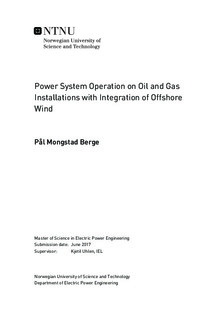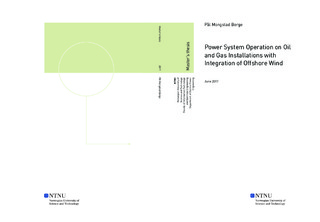| dc.description.abstract | This thesis investigates the operational aspects of integrating wind energy with the power supply to offshore oil and gas (O\&G) installations. The use of wind energy is an environmentally friendly and efficient way of supplying power to O\&G installations to reduce the dependence on gas turbines and lower the CO2 emissions. Wind measurements indicate excellent wind conditions offshore, and thus there is great potential to install wind energy to an O\&G installation. Wind power is a highly variable power source, and therefore the focus of this thesis is on frequency stability.
High wind penetration in the power system results in a different operational pattern for the system operators compared to conventional thermal power plants. Therefore, it is essential for the power system operator to understand how the integration of wind energy affects the power system stability. These impacts are investigated by conducting dynamic power system simulations.
A hybrid power system has been modeled consisting of two 13 MW gas turbines, a 6 MW wind turbine, and several loads. The level of complexity of the models is kept simple to reduce the computational requirements. The thesis presents dynamic models of the wind turbine and gas turbines, and how the components models are combined to generate the complete model. The system includes mechanical models of gas turbines and wind turbine. Wind model subsystems consist of wind turbine, drive train, blade pitch controller and maximum power point tracking controller. Gas turbine subsystems consist of governor, turbine and drive train.
A operator training simulator has been modeled and implemented in Simulink to give the power system operators knowledge on how wind power penetration affects the frequency variability on O\&G installations. The modeled operator training simulator gives the power system operators the chance to monitor and observe how the wind turbine and gas turbines perform under different load and wind variations. The power system operators also have the opportunity to execute simple control actions, for instance adjusting the speed reference set point of the gas turbine, perform load shedding and start or stop gas turbines.
In the simulation study, one gas turbine replaced either a 6 MW or 2.3 MW wind turbine. The wind turbine contributes with 10-45 \% of the total installed system capacity. The dynamic study investigates transient, steady state and periodic frequency deviations produced by variable operating conditions due to wind variations.
Wind events are simulated to study transient frequency deviations for different ramping capabilities of the gas turbine. Simulation results indicate that when the wind turbine operates at moderate wind speeds (10-16 m/s), it might cause undesirable periodic frequency deviations due to periodic power oscillations.
All other dynamic studies indicate that integration of the 6 MW wind turbine to an oil and gas installation is feasible. | |

